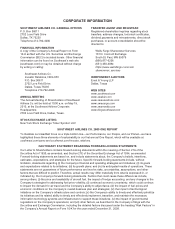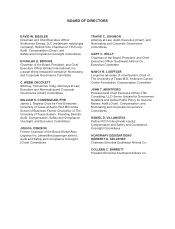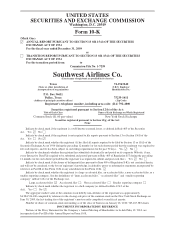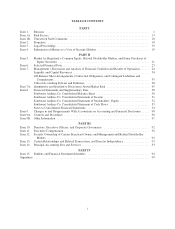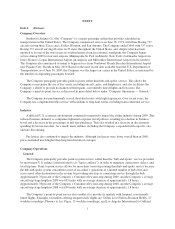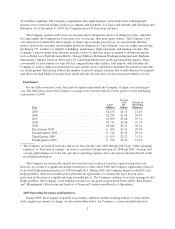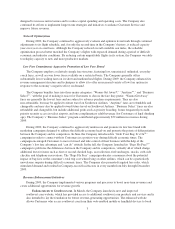Southwest Airlines 2009 Annual Report Download - page 15
Download and view the complete annual report
Please find page 15 of the 2009 Southwest Airlines annual report below. You can navigate through the pages in the report by either clicking on the pages listed below, or by using the keyword search tool below to find specific information within the annual report.ticketing and boarding, and revenue accounting systems, among others. The Company is also converting to a new
SAP Enterprise Resource Planning application, which will replace its general ledger, accounts payable, accounts
receivable, payroll, benefits, cash management, and fixed asset systems, with a goal of completion during 2010.
The conversion is designed to improve the Company’s key business processes by implementing an integrated
tool to increase efficiency, consistency, data accuracy, and cost effectiveness.
Regulation
The airline industry is heavily regulated, especially by the federal government. Examples of regulations
affecting the Company and/or the industry are discussed below.
Economic and Operational Regulation
The U.S. Department of Transportation. The U.S. Department of Transportation (the “DOT”) has
significant regulatory jurisdiction over passenger airlines. To provide passenger transportation in the United
States, a domestic airline is required to hold a Certificate of Public Convenience and Necessity issued by the
DOT. A certificate is unlimited in duration, and the Company’s certificate generally permits it to operate
among any points within the United States and its territories and possessions. Additional DOT authority, in
the form of a certificate or exemption from certificate requirements, is required for a U.S. airline to serve
foreign destinations either with its own aircraft or via codesharing with another airline. In 2009, the
Company applied for and received exemption authority from the DOT to provide air service between U.S.
points and Canadian points. Receipt of such authority is a precondition to being able to hold out any type of
air service between the United States and Canada, including service under a codesharing agreement with a
Canadian airline. The DOT may revoke a certificate or exemption, in whole or in part, for intentional failure
to comply with federal aviation statutes, regulations, orders, or the terms of the certificate itself.
The DOT also has jurisdiction over certain economic and consumer protection matters such as airline
codesharing, advertising, denied boarding compensation, baggage liability, and access for persons with
disabilities. The DOT may impose civil penalties on air carriers for violations of its regulations in these
areas. In December 2009, the DOT issued a new consumer protection rule addressing tarmac delays and
chronically late flights (i.e., flights that arrive more than 30 minutes late more than 50 percent of the time).
As part of the new rule, which is scheduled to go into effect in April 2010, passenger airlines are required to
adopt contingency plans that include the assurance that no domestic flight will remain on an airport tarmac
for more than three consecutive hours, unless there is a valid safety or security reason for doing so. The new
rule mandates that carriers provide adequate food and water to passengers if the aircraft remains on the
tarmac for two hours or more.
Aviation Taxes. The statutory authority for the federal government to collect aviation taxes, which are
used, in part, to finance the nation’s airport and air traffic control systems, and the authority of the FAA to
expend those funds must be periodically reauthorized by the U.S. Congress. This authority was originally
scheduled to expire on September 30, 2007. However, Congress has approved extensions of this authority,
with the most recent extension set to expire March 31, 2010. Other proposals that could be considered by
Congress in connection with the FAA reauthorization legislation include: (i) the imposition of new, or
changes to, aviation-specific taxes; (ii) an increase in the amount of airport passenger facility charges; and
(iii) the adoption of new unfunded mandates on commercial airlines such as new environmental, consumer,
and labor standards, any of which could have an impact on the Company’s operations.
The Wright Amendment. Section 29 of the International Air Transportation Competition Act of 1979,
as amended (commonly known as the “Wright Amendment”) prohibited the carriage of nonstop and through
passengers on commercial flights between Dallas Love Field and all states outside of Texas, with the
exception of the following states (the “Wright Amendment States”): Alabama, Arkansas, Kansas, Louisiana,
Mississippi, Missouri, New Mexico, and Oklahoma. Originally, the Wright Amendment permitted an airline
to offer flights between Dallas Love Field and the Wright Amendment States only to the extent the airline
did not offer or provide any through service or ticketing with another air carrier at Dallas Love Field and did
7


